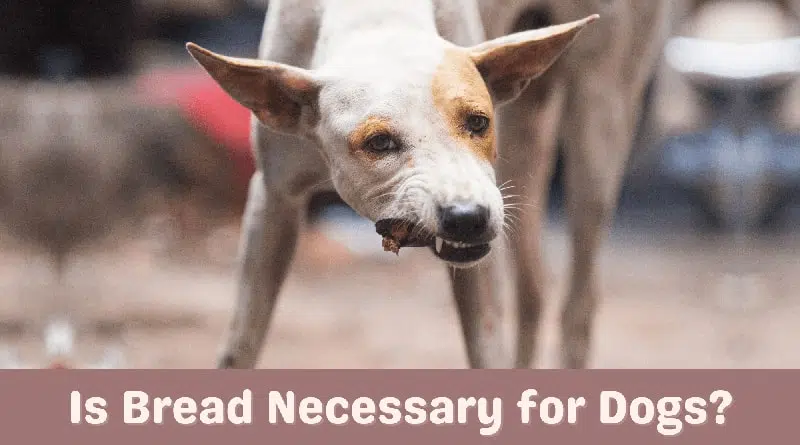Sharing your delicious treats with them is common, and bread might be on your mind. But before you toss that loaf their way, it’s important to understand whether dogs can safely consume bread. Here is the true and short answer to Can Dogs Eat Bread:
Can Dogs Eat Bread?
“Yes, Dogs can eat Bread safely in moderation, as long as it’s totally baked and doesn’t contain harmful ingredients like raisins, garlic, seeds, or Chocolate. It is typically not advised unless there may be a medical usefulness from it.”
In this informative article (Can Dogs Eat Bread), we’ll explore whether dogs can eat bread. We’ll provide expert insights backed by credible sources, ensuring you have the information to make informed decisions about your pet’s diet.
Can Dogs Eat Bread?

Let’s tackle the primary question right away: Can dogs eat bread? The answer is complex. While small quantities of plain bread may not harm most dogs immediately, there are better treats than this.
Bread contains specific ingredients that can be problematic for dogs, particularly in large amounts or if they have specific dietary sensitivities.
Popular Question: “Can Dogs Eat Breadfruit?“
The Risks of Feeding Bread to Dogs
- Obesity: Bread is calorie-dense and lacks the necessary nutrients for dogs. Feeding them bread frequently can contribute to weight gain and obesity.
- Allergies: Pets can create allergies to ingredients frequently discovered in bread, such as wheat, eggs, or dairy products.
- Digestive Upset: Bread contains gluten, which some dogs may have difficulty digesting. This can lead to gastrointestinal concerns like bloating, gas, and looseness of the bowels.
- Salt and Seasonings: Some sorts of bread might include high levels of salt, which is dangerous to pets. Additionally, certain seasonings like garlic and onion can be toxic to them.
Benefits of Feeding Bread to Dogs
- Energy Boost: For dogs engaging in intense physical activities, bread can provide a quick energy boost.
- Bonding Treat: Sharing a small piece of bread with your dog on occasion can be a way to strengthen the bond between you and your furry friend.
- Source of Carbohydrates: Bread can offer a small amount of carbohydrates to dogs, which may benefit highly active canines.
Bread Varieties Safe for Dogs
- Gluten-Free Bread: If your canine has gluten sensitivity, pick gluten-free bread as an occasional reward.
- Plain White Bread: Plain white bread without added seasonings or toppings is generally safe for dogs in small quantities.
- Whole Wheat Bread: Some dogs might endure entire wheat bread better than white bread; however, always present it in moderation.
Is Bread Necessary for Dogs?

While bread might be protected in percentages for many pet canines, it is not a required part of their diet program.
Pet dogs call for a well-balanced diet abundant in necessary nutrients, which can be achieved with premium pet dog food.
Types of Bread Dogs Can Eat
- Plain White Bread: Plain white bread without any added harmful ingredients can be considered safe for dogs. However, it must still be surrendered in percentages.
- Whole Wheat Bread: Whole wheat bread can be a healthier option for pets when given in percentages. It includes fiber, vitamins, and minerals that can benefit their gastrointestinal system.
- Bread with Minimal Additives: Bread with minimal ingredients, such as entire grain or oat bread, can be a much better selection than bread with excessive sugar or artificial sweeteners.
Types of Bread Dogs Should Avoid
- Bread with Xylitol: Xylitol is a sugar alternative that is highly poisonous to dogs and can cause fast insulin launch, leading to hypoglycemia. Dogs should never consume bread or any products containing xylitol.
- Bread with Chocolate: Chocolate is known to be toxic to dogs, and if a bread variety has chocolate, it must be kept far away from them.
- Bread with Raisins or Grapes: Raisins and grapes can be hazardous to dogs and may cause serious wellness concerns. Therefore, pet dogs should never receive any bread with raisins or grapes.
Popular Question: “Are All Calico Cats Female?“
Understanding a Dog’s Nutritional Needs
- Protein: Dogs need adequate protein for muscle maintenance and overall health. Look for dog foods with quality protein sources like meat or fish.
- Carbohydrates: Carbohydrates give energy, yet pets can get sufficient carbs from grains or veggies in their regular diet.
- Fats: Fats are necessary for a pet’s skin, layers, and wellness. Select foods with healthy and balanced fat sources like fish oil or hen fat.
- Vitamins and Minerals: A well-balanced diet plan should contain vitamins and minerals to support your pet’s immune system and promote health.
Alternatives to Bread for Dogs
Plenty of safe and healthy alternatives are available if you want to treat your furry friend without giving them bread.
Safe Treat Options
- Lean Meat: Prepared, unseasoned lean meats like chicken or turkey can be a delicious and nutritious pet reward.
- Fruits: Specific fruits like apples, bananas, and blueberries can create a pleasant, healthy, balanced reward.
- Vegetables: Canines can enjoy veggies such as carrots, environment-friendly beans, and cucumbers in moderation.
Homemade Dog Treat Recipe
Ingredients:
- 1 cup pumpkin puree
- 1/4 cup peanut butter (xylitol-free)
- 2 1/2 cups whole wheat flour (or gluten-free flour)
- Two eggs
Instructions:
- Preheat oven to 350°F (175°C).
- Mix pumpkin puree and peanut butter in a bowl.
- Include the eggs and mix them up until well integrated.
- Slowly include the flour as well as mix up until a dough kinds.
- Turn out the dough and cut it into preferred forms.
- Place the deals on a flat pan and cook for 20-25 minutes or until golden brown.
- Allow the treats to cool before serving.
Conclusion
In conclusion, while Dogs can eat bread in small amounts and plain varieties, it’s not the healthiest or most nutritious treat.
The risks of digestive upset, obesity, and potentially harmful ingredients make it best to reserve Bread for Dogs as an occasional indulgence.
Instead, concentrate on providing a balanced diet with high-grade pet food and consider much safer reward choices like lean meats, fruits, and vegetables. Hope now you have a clear picture of “Can Dogs Eat Bread?“.
Popular Question: “Dog Vitamin Water“
Disclaimer
This blog post (Can Dogs Eat Bread) contains basic information. We are not a veterinarian but we have Pet dietary professionals. If your Dog discloses any indication of ailment, call your veterinarian.
Bear in mind that every Dog is Different, and if you have any worries regarding your canine’s health or practices, do not wait to seek specialist recommendations from your veterinarian.
If you want more knowledge about Pet Nutrition, visit our Blog Section.
FAQs (Frequently Asked Questions)
Puppies have delicate digestive systems, so it’s best to avoid giving them bread until they are older.
Plain bread crusts in moderation should be okay, but avoid crusts with added toppings or seasonings.
In small quantities and without added herbs, bread crumbs are generally safe, but avoid large amounts.
Whole-grain bread may be safer than white bread for some dogs, but moderation is key.
Limiting bread to occasional treats and not exceeding 10% of their daily caloric intake is best.
No, garlic bread is not safe for dogs. Garlic is toxic to them and can lead to serious health issues.
Latest Articles
- Can Dogs Eat Soursop Fruit? Find Out the Truth Here
- Can Drug Dogs Smell Kratom? The Shocking Truth Revealed
- When Do Dogs Go into Heat after Having Puppies?
Subscribe to Pet Nutrition Guru
Subscribe below to receive expert pet care advice, pet wellness tips, and exclusive promotions.




